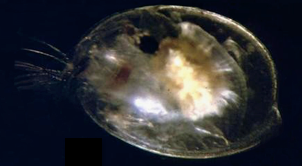By
Caitlin Lockard
When playing Frisbee with your dog, do you ever wonder how they have the ability to catch it so effortlessly? The art of being able to figure out where something like a Frisbee is headed requires some crazy math skills. Ostracods are one kind of animal that puts their wicked math skills to the test while finding a mate.
 |
| The image above of a female ostracod was provided by Trevor Rivers. |
You’ve never heard of an ostracod you say? Ostracods are small crustaceans, which basically means they have lots of legs and are covered by a hard shell. Male ostracods can be seen roaming throughout the ocean trying to enchant females with
light displays. Typically, just after sunset, males begin their light displays, which consist of two phases. The first phase is the bright phase, which is short. The goal here is to signal to the female that “I’m here, single (except all my buddies that I brought with me of course) and ready to mingle”. The second phase is where males spiral up in a helix while pulsing repeatedly. This phase is much dimmer and is used by females to choose a mate. But exactly how do female ostracods go about catching the moving and light-pulsing man of her dreams?
Scientists,
Trevor Rivers of the
University of Kansas and Jim Morin of
Cornell University, set off to explore if female ostracods try to intercept the moving and pulsing males or if they just chase them. In order to conduct this experiment, immature female ostracods were collected off the shore of Southwater Caye in Belize. After catching the ostracods, females were put into tanks and raised to maturity, ensuring that all the females were sexually mature virgins. Rivers and Morin put an LED light behind the different tanks in order to mimic an actual mating display. The LED light looked like a string of Christmas lights pulsing from bottom to top, mimicking the males’ helical light display. In the control group, there was an LED light placed behind the tank, however it was turned off. The duo questioned whether or not the LED light show was able to mimic the display put on by male ostracods. Also, they questioned how females respond to the males’ display by measuring the height at which females intercepted the LED light, how straight of a line the female swam in, if the female swam at an angle, and what direction the female swam in. Check out a video
here.
The scientists found that the LED light was able to mimic the helical phase that male ostracods put on well enough for the females to respond. Females in the control group merely swam at the same height, as there was no reason for her to waste her energy with no “male” around. However, females in the experimental group had to think on their feet to figure out where their male crush was heading. They swam directly toward but slightly above the “male” than when there was no “mate” around. If the female merely headed to the same spot where her “male” previously was, she would miss him. Instead, she had to anticipate where he was going next and head that direction.
What’s the moral of the story here? If you’re a female ostracod, your man will always be on the move, so you better have some gnarly geometry skills in order to track him down.
Work Cited:
Rivers, T., & Morin, J. (2013). Female ostracods respond to and intercept artificial conspecific male luminescent courtship displays Behavioral Ecology, 24 (4), 877-887 DOI: 10.1093/beheco/art022






